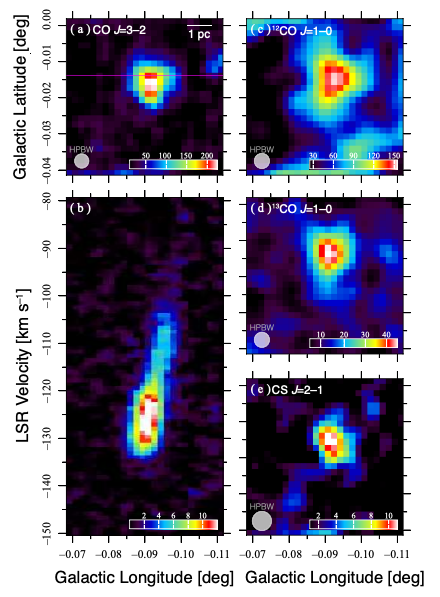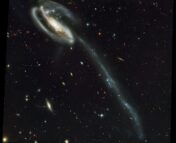
Tianyu Tu is a first-year PhD student at Nanjing University, whose main interest lies in studying the chemical effects of supernova remnants on molecular clouds. This guest post is in conjunction with an assignment for the Astronomical Literature Reading and Writing class taught by Professor Zhi-Yu Zhang.
Title: Discovery of the Tadpole Molecular Cloud near the Galactic Nucleus
Authors: Miyuki Kaneko, Tomoharu Oka, Hiroki Yokozuka, Rei Enokiya, Shunya Takekawa, Yuhei Iwata, Shiho Tsujimoto
First Author’s Institution: Graduate School of Science and Technology, Keio University, Japan.
Status: Published in ApJ [open access]
Intermediate-mass black holes: a missing part in black hole evolution
Most galaxies, including our own Milky Way, are known to harbor supermassive black holes (SMBHs) at their centers, each with a mass exceeding a million times that of our Sun. However, the origin of these SMBHs continues to be the subject of active debate among astronomers. One prevailing theory suggests that these SMBHs form through the merger of intermediate-mass black holes (IMBHs) with masses of approximately 102 to 105 times that of our Sun. The IMBHs themselves are believed to form in young compact star clusters as a result of the runaway merging of massive stars. While this scenario naturally explains most observational phenomena, a key question remains: where are these IMBHs located? Several candidates have been discovered, such as the ultra-luminous X-ray source ESO 243-49 HLX-1. However, none of them have been definitively identified as an IMBH.
In order to uncover the footprints of IMBHs, the authors focused on the essential property of black holes (BHs): gravity. The strong gravitational force exerted by BHs pulls the objects nearby to orbit around them. Such effect has led to the groundbreaking discovery of Sgr A*, the SMBH at the center of the Milky Way. Instead of stars, the authors turned their attention to the kinematics of molecular clouds, which are the denser regions of the interstellar medium. Similar to stars, if molecular clouds are subject to the gravitational pull of an IMBH, they would also exhibit an elliptical orbit.
The “Tadpole” molecular cloud

The authors utilized the data from carbon monoxide (12CO, 13CO) and carbon monosulfide (CS) lines observations towards the central molecular zone (CMZ) of our Galaxy, which is a complex of giant molecular clouds spanning the galactic center. CO serves as a tracer of molecular gas, while CS traces the denser regions. The Doppler effect of the molecular emission lines provides information about the gas kinematics, while the spectra of different transitions of a molecule reveal details about the thermodynamics. From the data, they found a “Tadpole” molecular cloud (Figure 1) located 2.6 arcminutes northwest of Sgr A*. At first glance, it appears to be a simple clump of molecular gas, but when observed in the longitude-velocity (l-v) map, its nature becomes distinct. The l-v map shows the radial velocity of the cloud across different Galactic Longitudes. In this map, the cloud exhibits a distinctive tadpole-like shape, with the “head” in the lower left and the “tail” extending towards the upper right, hence its name. A steep velocity gradient of ~16 km s-1 pc-1 is derived from the l-v map. A comprehensive multi-wavelength analysis, including radio, infrared, and X-ray observations, corroborates the absence of any energetic objects capable of generating such a large velocity gradient within the Tadpole.
To obtain a clearer view of the kinematics of the cloud, the authors plotted the cloud’s integrated intensity at various radial velocities, showing the emission across different velocity ranges (Figure 2). They identified the peak position of the emission at each velocity, and plotted the positions of all the peaks together, as seen in the bottom right panel of Figure 2. The observed positions of all the peaks clearly demonstrated a distinct movement from the lower left to the upper right of the panel, forming an arc on the plane of the sky. This indicates that the clouds with different velocities are located at different positions, resembling a Keplerian orbit.

Based on this deduction, the authors presented a fitting of a Keplerian orbit to explain the arc-shape spatial structure of the peak positions. They fitted nine parameters, including five parameters for the 3-dimensional orbit (excluding the true anomaly), as well as the mass, velocity and the latitude-longitude position of the dynamic center point. The fitting process yielded a satisfactory result (Figure 3), revealing that the Tadpole is orbiting around a point mass of 105 solar masses. The authors also investigated the distribution of line ratios along the Tadpole. The 12CO (3-2)/(2-1) ratio indicated a high gas temperature in the head of the Tadpole, likely caused by a shock occurring at the initial encounter with the mass, the same as “tidal compression” in fluid mechanics. These line ratios further support the Keplerian orbit model.

A hidden IMBH?
According to the best-fit model, a mass of 105 solar masses must be concentrated within a radius significantly smaller than 0.5 pc. The absence of a bright infrared counterpart towards the Tadpole, along with its high mass, ruled out a stellar cluster as a candidate for the point mass. Therefore, the most promising candidate is an IMBH. Three point-like X-ray sources have been identified as potential counterparts of the IMBH, despite their low X-ray luminosities. This suggests that the IMBH, if it indeed exists, is currently inactive with a very low mass accretion rate.
The authors of this paper have made an intriguing discovery of the Tadpole molecular cloud within the CMZ. The kinematics and line ratios observed in the Tadpole can be naturally explained by postulating its orbit around a point mass of 105 solar masses. They proposed that this point-like object could be an inactive IMBH. This finding expands the list of potential IMBH candidates and underscores the need for future high-resolution observations to directly map the orbit stream and further strengthen the reliability of the Keplerian orbit model.
Astrobite edited by: Janette Suherli
Featured image credit: Keio University




